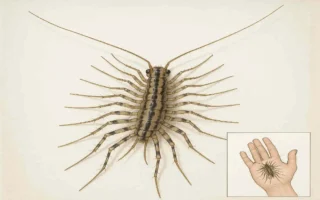Understanding the role of house centipedes in our homes is crucial. They are more than just a random insect that appears out of nowhere. By learning about their behavior, risks, and benefits, we can make informed decisions about how to coexist with them.
What Are House Centipedes?

Description and Physical Characteristics
House centipedes, scientifically known as Scutigera coleoptrata, are fascinating creatures characterized by their unique physical features. They typically grow between 1 and 1.5 inches long, with a flattened body and long, thin legs. The most striking aspect of house centipedes is their numerous legs, which can range from 15 to 177 pairs, depending on the species and age.
Typical Habitats Within Indoor Spaces
These critters are commonly found in damp, dark areas of your home, such as basements, bathrooms, and kitchens. They prefer hiding in cracks, crevices, and under objects, where they can easily access their prey and remain hidden from predators.
Life Cycle and Behavior Patterns
House centipedes undergo a simple metamorphosis, progressing through several stages from egg to adult. They are nocturnal hunters, actively searching for food during the night and hiding during the day. Their fast movement and ability to climb walls make them efficient predators.
Common Misconceptions About Centipedes
Many people mistakenly believe that house centipedes are harmful or dirty. However, these misconceptions often stem from their appearance and the fear of the unknown. In reality, house centipedes play a vital role in controlling other pest populations within our homes.
Are House Centipedes Harmful to Humans?
Explanation of House Centipede Bites: Rarity and Mildness
While house centipedes have venomous fangs, they rarely bite humans. If a bite does occur, it is usually painless and causes minimal swelling or irritation. The venom is not potent enough to cause significant harm to humans.
Possible Allergic Reactions or Irritation in Sensitive Individuals
In rare cases, individuals with sensitive skin or allergies may experience mild irritation or an allergic reaction after being bitten by a house centipede. However, these reactions are typically short-lived and can be easily treated with over-the-counter remedies.
Comparison of House Centipedes Versus Other Harmful Household Pests
When compared to other household pests, such as spiders or cockroaches, house centipedes pose a significantly lower risk to humans. They are not known to spread diseases or cause significant property damage. In fact, their presence can help control other pest populations.
Emphasize Low Risk and Non-Aggressive Nature
House centipedes are non-aggressive and will only bite if they feel threatened or cornered. They prefer to avoid human contact and focus on hunting their prey. The low risk associated with house centipedes makes them a relatively harmless indoor predator.
Are House Centipedes a Sign of Cleanliness?
Why Some People Associate Centipedes with Cleanliness or Uncleanliness
The presence of house centipedes in a home can lead to conflicting opinions about cleanliness. Some people believe that centipedes indicate a dirty or unkempt environment, while others see them as a sign of a clean home that attracts prey for the centipedes to hunt.
What Attracts House Centipedes Indoors: Moisture, Hidden Pests, Clutter, or Poor Hygiene?
House centipedes are attracted to indoor environments that provide moisture, food sources, and hiding spots. Factors such as leaky pipes, damp basements, and cluttered areas can create an ideal habitat for these critters. However, poor hygiene alone does not directly attract house centipedes.
How House Centipedes’ Presence Can Indicate an Underlying Pest Problem
The presence of house centipedes in your home may suggest an underlying pest issue, such as an infestation of silverfish, roaches, or spiders. Centipedes are drawn to these pests as a food source, and their presence can be an indicator of a larger problem that needs to be addressed.
Clarify That Centipedes Themselves Do Not Indicate Cleanliness or Dirt Directly, but Rather Environmental Conditions
It’s important to understand that house centipedes themselves do not directly indicate cleanliness or dirt. Instead, they are a symptom of the environmental conditions within your home. By addressing the root causes, such as moisture and pest infestations, you can reduce the likelihood of house centipedes appearing in your living space.
The Role of House Centipedes as Indoor Predators
Diet: Pests House Centipedes Prey Upon
House centipedes are voracious predators that feed on a variety of household pests. Their diet includes:
- Silverfish
- Roaches
- Spiders
- Ants
- Bed bugs
- Termites
By preying on these pests, house centipedes can help keep their populations in check, thereby reducing the need for chemical pest control measures.
Benefits of Having Centipedes as Natural Pest Controllers
Having house centipedes in your home can be beneficial in several ways:
- They help control other pest populations, reducing the need for chemical pesticides.
- They are a natural and eco-friendly solution to pest management.
- They can save you money on pest control services and products.
Balance Between Coexisting with House Centipedes and Controlling the Overall Pest Population
While house centipedes can be beneficial, it’s essential to strike a balance between coexisting with them and managing overall pest populations. If the number of centipedes becomes overwhelming or if they start to invade living spaces, it may be necessary to take action to control their numbers.
How Their Presence Can Reduce the Number of Other Harmful Pests
By preying on other pests, house centipedes can help reduce the number of harmful insects in your home. This can lead to a healthier and more comfortable living environment for you and your family.
Identifying House Centipedes Correctly
How to Distinguish House Centipedes from Other Insects or Spiders
House centipedes have several distinct characteristics that set them apart from other insects and spiders:
- Long, thin legs with 15 to 177 pairs
- Flattened body
- Fast, agile movement
- Ability to climb walls and ceilings
By familiarizing yourself with these features, you can accurately identify house centipedes and differentiate them from other pests.
Visual Characteristics to Look For
When trying to identify a house centipede, look for the following visual characteristics:
- Grayish-yellow body with dark stripes
- Long, beaded antennae
- Large, compound eyes
- Venomous fangs near the head
These features are unique to house centipedes and can help you confirm their identity.
Common Locations Within Homes Where They Are Found
House centipedes are commonly found in the following areas of your home:
- Basements
- Bathrooms
- Kitchens
- Laundry rooms
- Crawl spaces
These damp, dark areas provide the ideal habitat for house centipedes to thrive.
Seasonal Activity and Behavior Changes Indoors
House centipedes may exhibit seasonal changes in activity and behavior. During warmer months, they may be more active and visible as they search for food and mates. In colder months, they may seek shelter indoors and become less active.
How to Manage and Control House Centipedes

Preventive Measures for Deterring House Centipedes
To prevent house centipedes from entering your home, consider the following measures:
- Seal cracks and crevices around windows, doors, and foundations
- Reduce moisture by fixing leaky pipes and improving ventilation
- Keep your home clean and free of clutter
- Store food in airtight containers to discourage other pests
By addressing these factors, you can make your home less attractive to house centipedes and other pests.
Importance of Controlling Moisture and Reducing Clutter
Controlling moisture and reducing clutter are crucial steps in managing house centipedes. By eliminating damp areas and removing hiding spots, you can make your home less hospitable to these critters.
Tips for Sealing Entry Points and Maintaining Dry Environments
To seal entry points and maintain dry environments:
- Use caulk or weatherstripping to seal gaps around windows, doors, and utility lines
- Install dehumidifiers in damp areas like basements and bathrooms
- Ensure proper ventilation in kitchens, bathrooms, and laundry rooms
- Repair any leaks or water damage promptly
These measures can help prevent house centipedes from entering your home and thriving in moist environments.
Using Natural or Chemical Pest Control Options Safely
If you need to control house centipedes or other pests, consider using natural or chemical options safely:
- Natural options: Diatomaceous earth, boric acid, or essential oils like peppermint or lavender
- Chemical options: Insecticides specifically labeled for centipede control
Always follow the manufacturer’s instructions and take precautions to protect yourself, your family, and your pets when using any pest control products.
When to Call Professional Pest Control Services
If you have a severe infestation or if your efforts to control house centipedes are unsuccessful, it may be time to call professional pest control services. They can assess the situation, identify the root causes, and implement effective solutions to manage the problem.
House Centipedes and Home Hygiene: What You Should Know
Debunking Myths About House Centipedes and House Hygiene
There are several myths surrounding house centipedes and their relationship to home hygiene. Let’s debunk some of these misconceptions:
- Myth: House centipedes only appear in dirty homes.
- Fact: House centipedes can appear in both clean and dirty homes, as they are attracted to moisture and prey.
- Myth: House centipedes are a sign of poor housekeeping.
- Fact: House centipedes are more indicative of environmental conditions like moisture and pest infestations than housekeeping habits.
Correlation Between Proper Home Maintenance and Reduced Pest Intrusion
Proper home maintenance plays a significant role in reducing pest intrusion, including house centipedes. By addressing issues like moisture, clutter, and entry points, you can create a less inviting environment for pests.
Impact of Regular Cleaning, Ventilation, and Pest-Proofing on Centipede Presence
Regular cleaning, proper ventilation, and pest-proofing measures can help reduce the presence of house centipedes in your home:
- Regular cleaning: Vacuuming, dusting, and mopping can remove food sources and hiding spots for pests.
- Proper ventilation: Improving air circulation can help reduce moisture and discourage centipedes.
- Pest-proofing: Sealing entry points and eliminating pest attractants can prevent centipedes from entering your home.
By incorporating these practices into your routine, you can create a less hospitable environment for house centipedes and other pests.
Should You Keep or Get Rid of House Centipedes?
Pros and Cons of Allowing House Centipedes in Your Home
There are both pros and cons to allowing house centipedes to coexist in your home:
Pros:
- Natural pest control: House centipedes can help keep other pest populations in check.
- Eco-friendly: Allowing house centipedes to live in your home is a natural and environmentally friendly approach to pest management.
- Cost-effective: By letting house centipedes control other pests, you may save money on pest control services and products.
Cons:
- Unpleasant appearance: Some people find the appearance of house centipedes unsettling or creepy.
- Potential for bites: While rare, house centipedes can bite if threatened or cornered, causing mild irritation.
- Difficulty controlling numbers: If the population of house centipedes becomes too large, it may become challenging to manage their numbers effectively.
Situations Where Removal Becomes Necessary
In certain situations, removing house centipedes from your home may be necessary:
- Severe infestation: If the number of house centipedes becomes overwhelming or starts to invade living spaces, removal may be required.
- Allergic reactions: If someone in your household experiences an allergic reaction to a house centipede bite, removal may be necessary to prevent further incidents.
- Personal discomfort: If the presence of house centipedes causes significant distress or anxiety, removal may be the best option for your mental well-being.
Ethical and Environmental Considerations in Handling Indoor Predators
When deciding whether to keep or remove house centipedes, consider the ethical and environmental implications:
- Ethical considerations: House centipedes are living creatures that play a role in the ecosystem. Consider humane methods of removal or coexistence whenever possible.
- Environmental considerations: Using chemical pesticides to control house centipedes can have negative impacts on the environment and other beneficial insects. Opt for natural or eco-friendly solutions when possible.
By weighing these factors, you can make an informed decision that balances your needs with the well-being of the clean centipedes and the environment.




